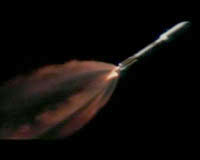| . |  |
. |
San Diego CA (SPX) Mar 10, 2011 On Jan. 21, Northrop Grumman, Defense Advanced Research Projects Agency (DARPA) and NASA Dryden Flight Research Center took a major step toward demonstrating autonomous aerial refueling between two unmanned, high altitude aircraft, an operation never before performed. In a key risk reduction flight test, Northrop Grumman's Proteus test aircraft and a NASA Global Hawk flew as close as 40 feet apart at an altitude of 45,000 feet, an industry-setting record. The flight test was conducted in the challenging high altitude environment required for refueling of high altitude long endurance (HALE) unmanned aircraft systems (UAS). Wake turbulence between the two aircraft as well as engine performance and flight control responsiveness in the stratosphere were evaluated. Simulated breakaway maneuvers were also conducted. The January flight was key to reducing risks as the program prepares for autonomous aerial refueling of two Global Hawks in the spring of 2012. "Demonstrating close formation flight of two high altitude aircraft, whether manned or unmanned, is a notable accomplishment," said Geoffrey Sommer, KQ-X program manager at Northrop Grumman Aerospace Systems sector. "When you add autonomous flight of both aircraft into the mix, as we will do later in the KQ-X program, you gain a capability that has mission applications far beyond just aerial refueling." The $33 million DARPA KQ-X program will demonstrate autonomous fuel transfer between two Global Hawks, enabling flights of up to one week endurance. KQ-X is a follow-on to a 2006 DARPA Autonomous Aerial Refueling Demonstration (AARD), in joint effort with NASA Dryden, which used an F-18 fighter jet as a surrogate unmanned aircraft to autonomously refuel through a probe and drogue from a 707 tanker. Northrop Grumman supports the operation of the two Global Hawks used in the KQ-X program under the terms of a Space Act Agreement with its NASA Dryden partner and is responsible for all engineering design, as well as modification of both aircraft.
Share This Article With Planet Earth
Related Links Defense Advanced Research Projects Agency (DARPA) UAV News - Suppliers and Technology
 Second Orbital Test Vehicle X-37B Begins Flight
Second Orbital Test Vehicle X-37B Begins FlightCape Canaveral FL (SPX) Mar 07, 2011 Boeing has announced the successful launch of the second Boeing-built X-37B Orbital Test Vehicle (OTV) for the U.S. Air Force Rapid Capabilities Office (RCO). The OTV was launched on an Atlas V rocket into a low-Earth orbit today at 5:46 p.m. Eastern time from Cape Canaveral Launch Complex 41. "History was made in December when the X-37B became the United States' first unmanned vehicle to ... read more |
|
| The content herein, unless otherwise known to be public domain, are Copyright 1995-2010 - SpaceDaily. AFP and UPI Wire Stories are copyright Agence France-Presse and United Press International. ESA Portal Reports are copyright European Space Agency. All NASA sourced material is public domain. Additional copyrights may apply in whole or part to other bona fide parties. Advertising does not imply endorsement,agreement or approval of any opinions, statements or information provided by SpaceDaily on any Web page published or hosted by SpaceDaily. Privacy Statement |